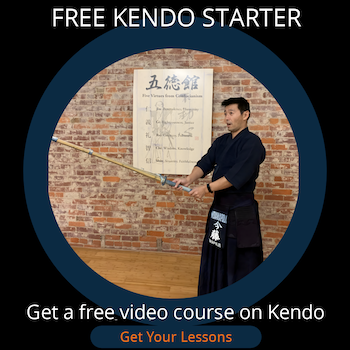Need Kendo Instructions?
You Got It!
You Got It!
Should there be any "play" in your left hand in the transition from raising the long sword to initiating a cut?
by Keith
(Raleigh, NC)
I have two questions that kind of relate (at least in my mind) to the fundamental way I cut with my sword.
I am a beginner, and as I watched and read all of the basics that I could find, there is an emphasis on beginners taking a "full" and broad swing when executing a cut. So as to learn the correct basic nature of how the sword is meant to cut.
When practicing these fuller, longer, and broader cuts, it gave me the feeling of using the momentum of bringing the sword up and back, and then using the natural tension (kind of like a rubber band) the cut then kind of "whipped" back... which seemed to make sense and felt quicker and natural.
But at the dojo I practice, there is a more practical aspect to the Kendo that I've been taught (it’s a more informal non-profit organization). Not to mention, I had already noticed that iodan starts with the sword in a "ready-to-attack" position, and that position is a much shorter potential swing (as the left hand is only a fist length from the forehead, and the sword seems to be held at around a 45 degree angle).
Furthermore, one of the more senior members of our dojo told me that when holding the sword up at the top of the backswing, at the initiation of the cut, the tip of the sword should not dip first (which is what I was doing, by kind of throwing the sword forward by relaxing my shoulders and then throwing them straight forward like a whip, attempting to make the cut kind of whip forward from a relaxed loose position)
Any information on the mechanics of the swing,
Also the question about "play" in your left hand, at the top of the back swing, should the tsuka kind of "rock back" with loose fingers around it, before commencing the cut, or should the same grip be held the entire times, just allowing the wrists to relax, but not so much the grip (if that makes any sense?)
Thank you, sorry if that was really confusing, I've been thinking about it too much :)
Answer: I assume that you are talking about kendō not iaidō. The reason I have to separate those is that we have many different iaidō styles and they have different theories.
In kendō, when we lift our sword up we do not loosen our left hand. Also we do not want to drop the tip of the sword too low.
Yes there is a suburi in which we swing back a shinai until it touches our bottom. We do this so we can warm up the muscles well and we can tell if our swing is straight or not by where the shinai hits on the bottom.
Small strikes should be small version of big strikes. Yes we have many ways to execute small cuts. We have so many of them, but not many know those variations.
If you remember that small and quick cuts are smaller and quicker version of big cuts, then you should not confuse those two types of cuts.
I hope I answered your questions.
Click here to read or post comments

